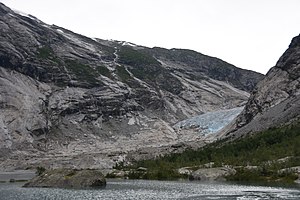Nigardsbreen
| Nigardsbreen | ||
|---|---|---|
|
Nigardbreen in July 2019 |
||
| location | Vestland ( Norway ) | |
| Mountains | Scandinavian mountains | |
| Type | Outlet glacier | |
| length | 9.6 km | |
| surface | 45.9 km² | |
| Altitude range | 1957 m - 315 m | |
| Coordinates | 61 ° 41 '12 " N , 7 ° 11' 45" E | |
|
|
||
Nigardbreen describes a glacier tongue of the Jostedalsbreen that descends from the upper Jostedal near Gaupne ( Luster ) . The Nigardsbreen makes up about 10% of the area of the Jostedalsbreen.
The name Nigardsbreen goes back to the settlement of Nigard . This was destroyed in a rapid glacier advance in 1743 (three kilometers in approx. 50 years).
Nearby is the Breheimsenteret Museum , which describes the formation of glaciers and the flora and fauna of the area. In the valley of the glacier is the lake Nigardsbrevatnet , above which you can take a small boat to get close to the glacier. There then follows a footpath of about 1/2 hour over rocks and scree.
glaciology
Emergence
Norway's glaciers are not to be seen as relics of the Ice Age . During a post-glacial warm period, the entire area became ice-free, so that the glaciers formed during the Ice Age had melted. In the subatlantic (approx. 500 BC) there was a deterioration in the climate. This was marked by a drop in the snow line. Therefore today's glaciers originate from this period.
Historical development
The Nigardsbreen reached its greatest extent in 1748, so far the glacier has retreated by about four kilometers. In the 1930s, a 1.5 km long ice reservoir formed as a result of the retreat. It is dammed by the moraine ridge.
The behavior of the Nigardsbreen has been observed since 1899. From 1899 to 1972 the glacier retreated 2.4 km. However, a decrease in retreat speed has been observed since the mid-1970s. From 1975 to 1989 there were only minimal changes in glacier length. From 1990 to 2000 there was an advance behavior, the glacier grew by 250 m. Movements of retreats were then recorded again. From 2000 to 2010 the glacier retreated by about 100 m, from 2010 to 2016 by 250 m. In the hot summer of 2018, the glacier melted back over 100 m.
Web links
Individual evidence
- ↑ a b GLACIER “NIGARDSBREEN” . GLACIORISK EUROPEAN PROJECT. 2001. Retrieved September 20, 2014.
- ↑ a b c d Nigardsbreen - 2297 . Norwegian Water Resources and Energy Directorate. 2013. Retrieved September 20, 2014.
- ↑ Nigardsbreen . Norwegian Water Resources and Energy Directorate. September 16, 2014. Archived from the original on May 26, 2015. Info: The archive link has been inserted automatically and has not yet been checked. Please check the original and archive link according to the instructions and then remove this notice. Retrieved September 20, 2014.
- ^ J Oerlemans: An attempt to simulate historic front variations of Nigardsbreen, Norway . In: Theoretical and Applied Climatology . 37, No. 3, September 1986, pp. 126-135. doi : 10.1007 / BF00867846 .
- ↑ Bernhard K. Reichert: Quantification of natural climate variability in paleoclimatic proxy data using general circulation models: application to glacier systems . Max Planck Inst. for meteorology, Hamburg 2000.

